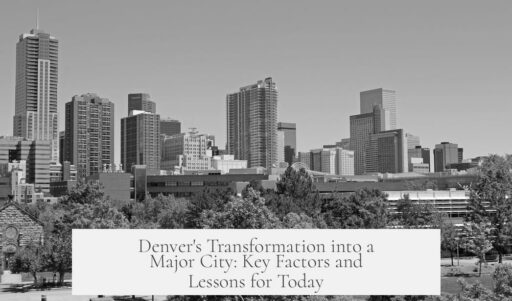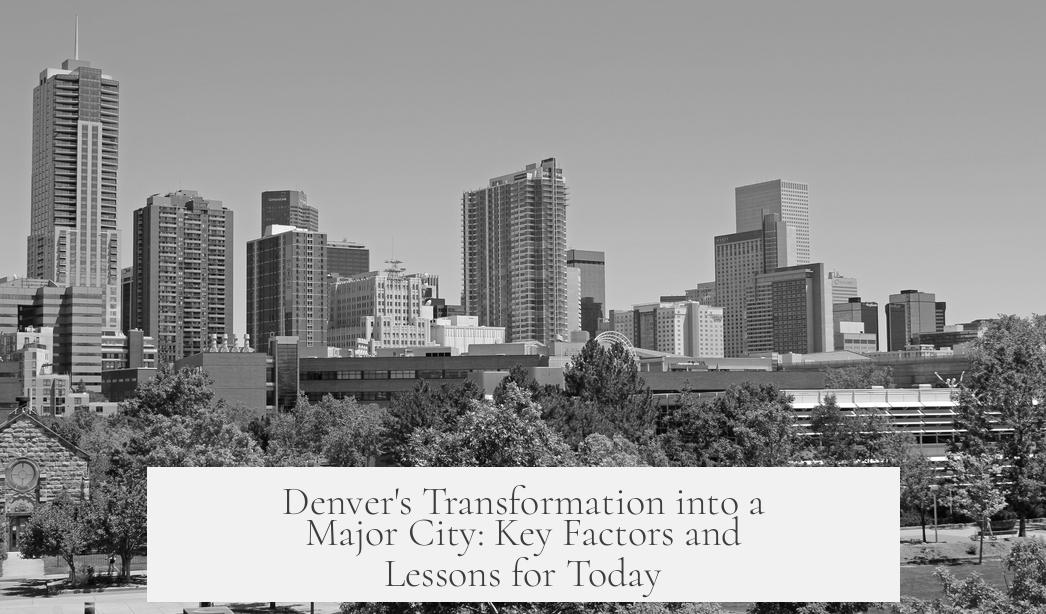Denver became an important and large city due to its strategic role during the Pike’s Peak Gold Rush and its development into a regional transportation hub, supported by ongoing mineral wealth and infrastructure growth.
The initial foundation for Denver’s importance was the Pike’s Peak gold rush of 1858. This event triggered a rush of prospectors to the area, creating demand for goods and services. Small settlements along Cherry Creek quickly merged into what became Denver. The city grew around this influx, with official institutions like a post office and businesses forming to serve gold-seekers. Economic activity from mining catalyzed early urban growth.
Denver’s expansion accelerated through transportation developments, especially railroads. Initially, the transcontinental railroad bypassed Denver, posing a threat to its growth. To counter this, local residents financed the Denver Pacific railroad, which arrived in 1870. This railroad link caused Denver’s population to soar by nearly 650 percent in the following decade. Railroads were essential to supply mining operations with heavy equipment and materials. Denver’s location made it a critical gateway between mines and broader railroad networks, enabling it to become a transport hub across Colorado. By the century’s end, Denver sat at the center of a spoke-like railroad system supporting a booming regional economy.
Sustaining this growth beyond the typical boomtown phase required continued mineral development and infrastructure. Denver’s population had dip during the Civil War but rebounded quickly afterward. The discovery of gold just in time helped it avoid collapse during downturns common to mining towns. Denver evolved into a permanent settlement by balancing resource extraction with growing transportation links and urban infrastructure, avoiding the fate of many short-lived mining camps.
| Factors | Impact on Denver |
|---|---|
| Pike’s Peak Gold Rush | Attracted prospectors, sparked initial settlements |
| Local financing of Denver Pacific Railroad | Connected Denver to national rail network |
| Strategic location | Hub for mining supply and trade |
| Continued mineral development | Supported economic sustainability |
- Gold rush created initial growth and settlement.
- Railroad connectivity drove explosive population increase.
- Denver’s location made it a regional transportation hub.
- Long-term growth depended on mineral wealth and infrastructure.
Why Did Denver Become Such an Important Big City?

Denver’s rise to prominence boils down to one main storyline: gold rush excitement sparked early growth, but smart moves around transportation and sustained economic activity transformed it into a major city. Let’s dig deeper into this fascinating journey.
First, the story really kicks off with the Pike’s Peak Gold Rush in the late 1850s. Imagine thousands of hopeful prospectors flooding into the area, dreaming of striking it rich. These prospectors didn’t just pan for gold; they attracted savvy businessmen eager to meet the needs of these fortune hunters. This commercial buzz gave birth to several small settlements on and around Cherry Creek, which eventually merged to form Denver.
Before long, the U.S. government threw in its weight with a post office, adding legitimacy. Stores popped up, and a bustling, though rough-and-tumble, economy took shape. The rumors about gold weren’t just whispers—they played out big time, turning Denver into a local hotspot. Without Pike’s Peak, Denver might still be a quiet patch of land.
So, if gold rushes were all it took, why isn’t Denver just a “boomtown ghost town” like many others? The answer lies in its next big stroke of luck: railroads.
The transcontinental railroad, the game-changer of the 19th century, actually bypassed Denver initially. Talk about bad timing! City leaders didn’t just sit around whining. Nope, they rolled up their sleeves, raised bonds, and built the Denver Pacific Railroad themselves. Denverans believed in their city—and invested in its future.
When the railroad finally rolled in on August 22, 1870, everything changed. Denver’s population didn’t just inch up; it **exploded**, shooting up nearly 650% between 1870 and 1880. The railroad connected Denver to booming mining operations like Leadville. This meant Denver wasn’t just a place to strike gold anymore—it was a critical supply hub.
Being a transportation hub turned Denver into a regional powerhouse. Railroads looked like spokes on a wheel all leading to Denver at the center. Supplies, people, and wealth flowed through the city. This link to mining towns and the wider country was essential. Think of Denver as the gateway city connecting raw resources to markets. Without it, the Colorado mining boom would have been slower, costlier, and messier.
But call it a gold rush town only, and you miss the real magic. Denver didn’t just survive its early boom; it laid deep roots.
Here’s a fun comparison: Denver’s early years share a lot with Fairbanks, Alaska. Both started as gold rush boomtowns, with transportation routes and steady mineral development pulling them into the future. If gold had been harder to find, Denver could have easily become a ghost town.
Instead, the city’s timing was impeccable. While the population hovered around 4,700 before 1870, the Civil War caused a dip—a tough crowd for any city. But once peace returned, Denver bounced back, growing steadily rather than crashing hard as some mining towns did.
Transportation and mining didn’t just spark growth—they made it last. Continued mineral development kept the money flowing. Railroads weren’t just trains; they were lifelines connecting Denver to emerging industries and markets. This combo helped Denver shift from a speculative boomtown into a well-rounded urban center by the century’s end.
In short, Denver’s importance sprang from gold-fueled beginnings, but its sustained growth came from residents who believed in their city enough to build vital railroads and capitalize on mining wealth long-term. It’s a story of grit, strategy, and a bit of pioneer spirit.
So, what lessons can we take from Denver’s growth for today?
- Opportunities spark growth, but infrastructure drives sustainability.
- Community investment can overcome rejection by external players.
- Strategic location is a huge advantage—Denver’s proximity to mineral resources and transportation routes made it a natural hub.
- Economic diversity, here mining plus trade, anchors cities through boom and bust cycles.
Next time you think of Denver, picture prospectors chasing gold, residents rallying to fund railroads, and a city transforming from a wild frontier town into a thriving regional capital. That’s why Denver remains a cornerstone of the American West.




